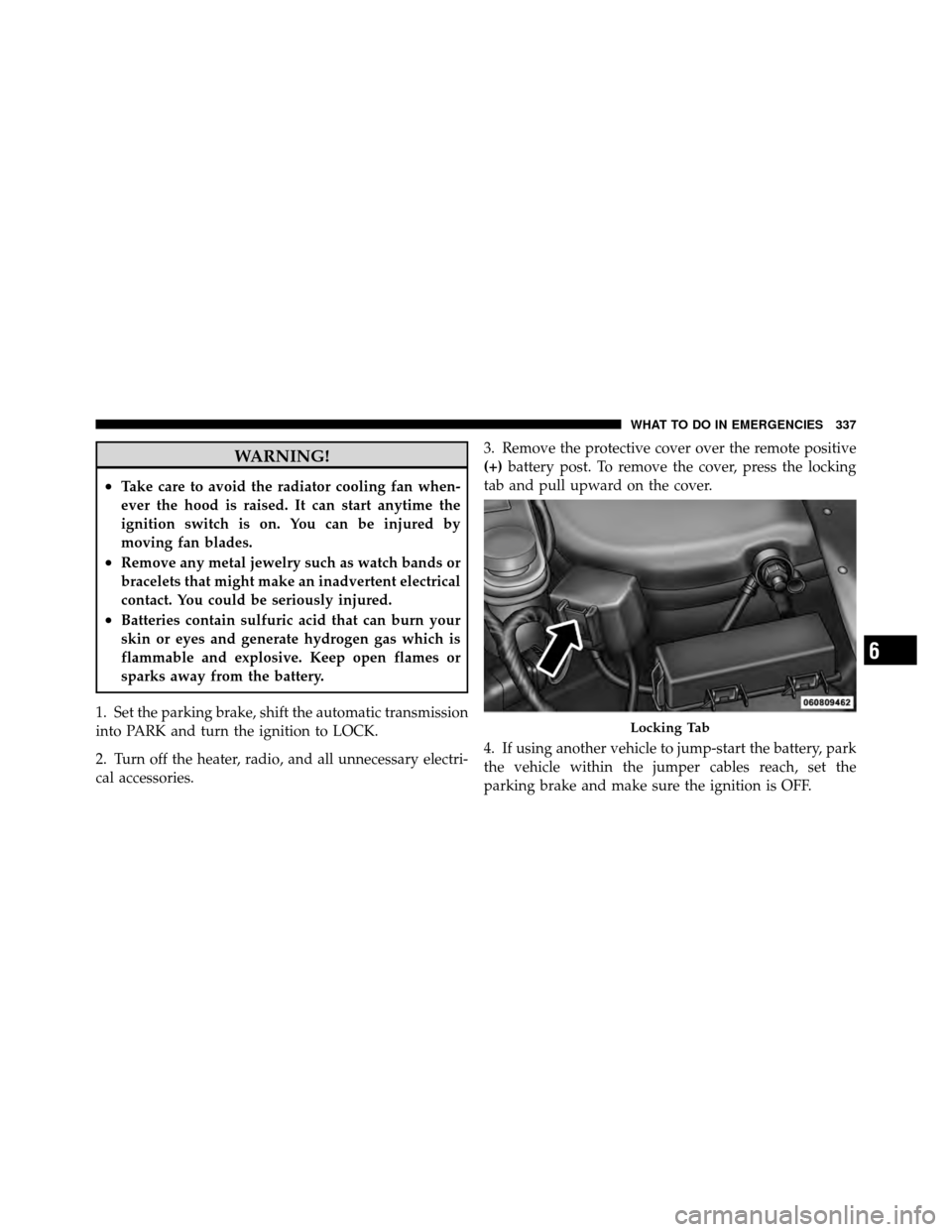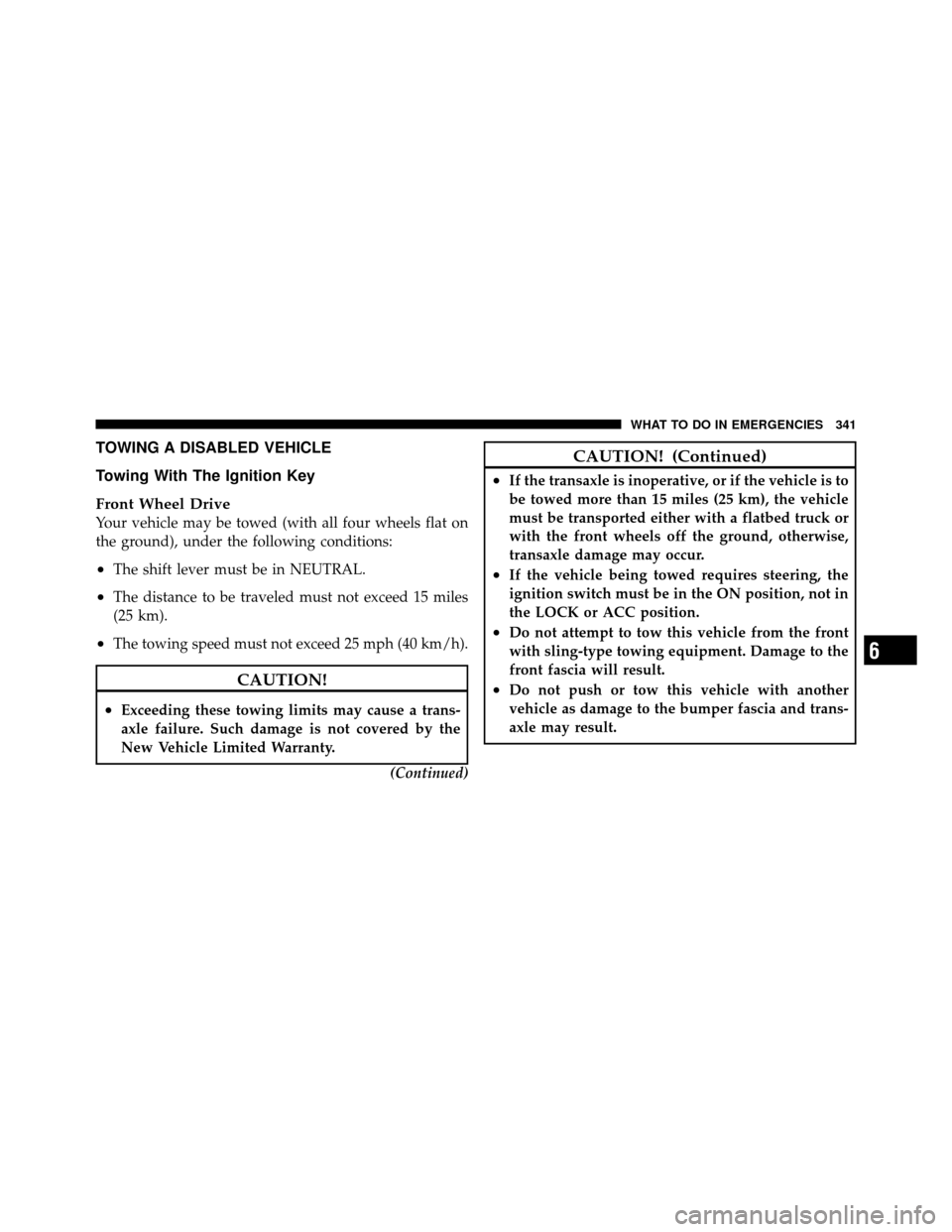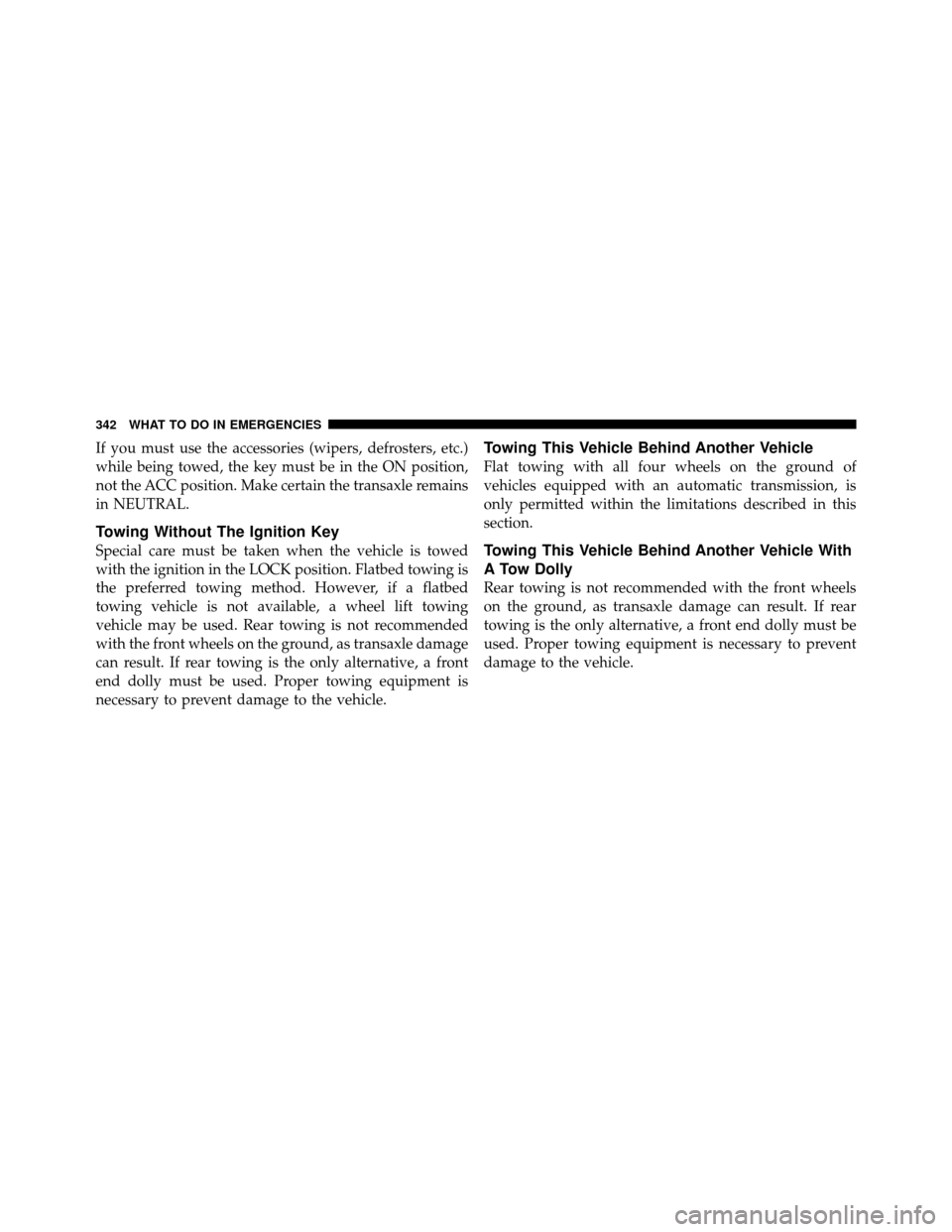Page 305 of 448

CAUTION! (Continued)
•An out-of-tune engine, or certain fuel or ignition
malfunctions, can cause the catalytic converter to
overheat. If you notice a pungent burning odor or
some light smoke, your engine may be out of tune
or malfunctioning and may require immediate
service. Contact your authorized dealer for service
assistance.
•The use of fuel additives, which are now being
sold as octane enhancers, is not recommended.
Most of these products contain high concentra-
tions of methanol. Fuel system damage or vehicle
performance problems resulting from the use of
such fuels or additives is not the responsibility of
the manufacturer.
NOTE: Intentional tampering with emissions control
systems can result in civil penalties being assessed
against you.
Carbon Monoxide Warnings
WARNING!
Carbon monoxide (CO) in exhaust gases is deadly.
Follow the precautions below to prevent carbon
monoxide poisoning:
•Do not inhale exhaust gases. They contain carbon
monoxide, a colorless and odorless gas, which can
kill. Never run the engine in a closed area, such as
a garage, and never sit in a parked vehicle with the
engine running for an extended period. If the
vehicle is stopped in an open area with the engine
running for more than a short period, adjust the
ventilation system to force fresh, outside air into
the vehicle.
(Continued)
304 STARTING AND OPERATING
Page 327 of 448
�Towing A Disabled Vehicle ............... 341
▫ Towing With The Ignition Key ........... 341
▫ Towing Without The Ignition Key ........ 342
▫ Towing This Vehicle Behind
Another Vehicle ..................... 342 ▫
Towing This Vehicle Behind Another Vehicle
With A Tow Dolly .................... 342
▫ Towing Without Power — Override
Transaxle Interlock System .............. 343
326 WHAT TO DO IN EMERGENCIES
Page 328 of 448

HAZARD WARNING FLASHER
The Hazard Warning flasher switch is located on the
instrument panel, below the radio.Press the switch to turn on the Hazard Warning
flasher. When the switch is activated, all directional
turn signals will flash on and off to warn oncoming
traffic of an emergency. Press the switch a second time to
turn off the Hazard Warning flasher.
This is an emergency warning system and should not be
used when the vehicle is in motion. Use it when your
vehicle is disabled and is creating a safety hazard for
other motorists.
If it is necessary to leave the vehicle to go for service, the
Hazard Warning flasher will continue to operate with the
ignition key removed and the vehicle locked.
NOTE: With extended use, the Hazard Warning flasher
may wear down your battery.
IF YOUR ENGINE OVERHEATS
In any of the following situations, you can reduce the
potential for overheating by taking the appropriate ac-
tion.
•On the highways — Slow down.
•In city traffic — While stopped, put transaxle in
NEUTRAL, but do not increase engine idle speed.
CAUTION!
Driving with a hot cooling system could damage
your vehicle. If temperature gauge reads “H”, pull
over and stop the vehicle with the engine at idle,
when safe. Turn the air conditioner off and wait until
the pointer drops back into the normal range. After
appropriate action has been taken, if the pointer
remains on the “H”, turn the engine off immediately,
and call for service.6
WHAT TO DO IN EMERGENCIES 327
Page 331 of 448
Preparations For Jacking
1. Park the vehicle on a firm, level surface. Avoid ice or
slippery areas.
WARNING!
Do not attempt to change a tire on the side of the
vehicle close to moving traffic. Pull far enough off
the road to avoid the danger of being hit when
operating the jack or changing the wheel.
2. Set the parking brake.
3. Place the shift lever into PARK (automatic transaxle)
or REVERSE (manual transaxle).
4. Turn OFF the ignition.
5. Turn on the Hazard Warning flasher. 6. Block both the front and rear of the
wheel diagonally opposite the jacking
position. For example, if changing the
right front tire, block the left rear
wheel.
NOTE: Passengers should not remain in the vehicle
while the vehicle is being jacked.
Jacking Instructions
WARNING!
Carefully follow these tire changing warnings to
help prevent personal injury or damage to your
vehicle:
(Continued)
330 WHAT TO DO IN EMERGENCIES
Page 338 of 448

WARNING!
•Take care to avoid the radiator cooling fan when-
ever the hood is raised. It can start anytime the
ignition switch is on. You can be injured by
moving fan blades.
•Remove any metal jewelry such as watch bands or
bracelets that might make an inadvertent electrical
contact. You could be seriously injured.
•Batteries contain sulfuric acid that can burn your
skin or eyes and generate hydrogen gas which is
flammable and explosive. Keep open flames or
sparks away from the battery.
1. Set the parking brake, shift the automatic transmission
into PARK and turn the ignition to LOCK.
2. Turn off the heater, radio, and all unnecessary electri-
cal accessories. 3. Remove the protective cover over the remote positive
(+)
battery post. To remove the cover, press the locking
tab and pull upward on the cover.
4. If using another vehicle to jump-start the battery, park
the vehicle within the jumper cables reach, set the
parking brake and make sure the ignition is OFF.
Locking Tab
6
WHAT TO DO IN EMERGENCIES 337
Page 342 of 448

TOWING A DISABLED VEHICLE
Towing With The Ignition Key
Front Wheel Drive
Your vehicle may be towed (with all four wheels flat on
the ground), under the following conditions:
•The shift lever must be in NEUTRAL.
•The distance to be traveled must not exceed 15 miles
(25 km).
•The towing speed must not exceed 25 mph (40 km/h).
CAUTION!
•Exceeding these towing limits may cause a trans-
axle failure. Such damage is not covered by the
New Vehicle Limited Warranty.(Continued)
CAUTION! (Continued)
•If the transaxle is inoperative, or if the vehicle is to
be towed more than 15 miles (25 km), the vehicle
must be transported either with a flatbed truck or
with the front wheels off the ground, otherwise,
transaxle damage may occur.
•If the vehicle being towed requires steering, the
ignition switch must be in the ON position, not in
the LOCK or ACC position.
•Do not attempt to tow this vehicle from the front
with sling-type towing equipment. Damage to the
front fascia will result.
•Do not push or tow this vehicle with another
vehicle as damage to the bumper fascia and trans-
axle may result.
6
WHAT TO DO IN EMERGENCIES 341
Page 343 of 448

If you must use the accessories (wipers, defrosters, etc.)
while being towed, the key must be in the ON position,
not the ACC position. Make certain the transaxle remains
in NEUTRAL.
Towing Without The Ignition Key
Special care must be taken when the vehicle is towed
with the ignition in the LOCK position. Flatbed towing is
the preferred towing method. However, if a flatbed
towing vehicle is not available, a wheel lift towing
vehicle may be used. Rear towing is not recommended
with the front wheels on the ground, as transaxle damage
can result. If rear towing is the only alternative, a front
end dolly must be used. Proper towing equipment is
necessary to prevent damage to the vehicle.
Towing This Vehicle Behind Another Vehicle
Flat towing with all four wheels on the ground of
vehicles equipped with an automatic transmission, is
only permitted within the limitations described in this
section.
Towing This Vehicle Behind Another Vehicle With
A Tow Dolly
Rear towing is not recommended with the front wheels
on the ground, as transaxle damage can result. If rear
towing is the only alternative, a front end dolly must be
used. Proper towing equipment is necessary to prevent
damage to the vehicle.
342 WHAT TO DO IN EMERGENCIES
Page 344 of 448
Towing Without Power — Override Transaxle
Interlock System
Special care must be taken when the vehicle is towed
with the ignition in the LOCK position. A dolly should be
used under the front wheels if the rear wheels are raised.
Proper towing equipment is necessary to prevent dam-
age to the vehicle.
Battery power is required to release the brake/transaxle
interlock system. There is an override system that allows
you to shift out of PARK in case of loss of power. To
activate the override system:
•Firmly apply the parking brake.
•Insert the ignition key and rotate it to the ON position.
•Remove the cupholder liner.
•Insert a key, screwdriver, or similar object into the
front hole then push and hold the manual override
release lever forward.
•While holding the release lever forward, move the
shift lever from PARK to NEUTRAL.
•Release the override.
6
WHAT TO DO IN EMERGENCIES 343